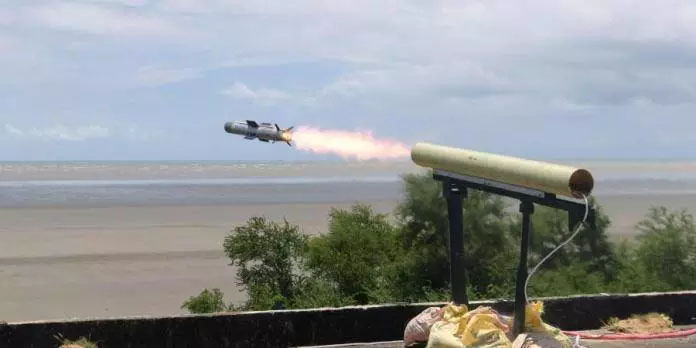Dhruvastra, Missile Test-Fired Successfully
23 July, 2020
In the midst of the COVID-19 pandemic, India effectively directed two rounds of helicopter-propelled Nag missile (HeliNa), renamed as Dhruvastra from a guard base off Odisha coast in consistence with coronavirus wellbeing conventions.
The flight preliminaries of India’s indigenously evolved anti-tank guided missile ‘Dhruvastra’ were effectively directed at the Interim Test Range (ITR) at Chandipur in Odisha under recreated conditions on July 15 and 16.
As indicated by reports, the preliminaries of the helicopter-propelled Nag Missile (HeliNa), which has now been named as ‘Dhruvastra’ hostile to tank guided missile, were led in immediate and top assault mode on July 15 and 16. The preliminary was directed without a helicopter.
HeliNa has been named after the Advanced Light Helicopter (ALH) Dhruv, which will be outfitted with the missile. Fitted with imaging Infra-Red searcher, Dhruvastra works in ‘lock-on before dispatch mode’.
Created by the Defense Research and Development Organization (DRDO), the helicopter-propelled hostile to tank guided missile (ATGM) is one of the most progressive enemies of tank weapons on the planet. A guard official said the missile was test-terminated from a ground-based launcher as a compulsory prerequisite for security.
“The crucial effective. The test demonstrated that the framework has gotten increasingly steady. The missile would before long be tried from the ALH after several additional preliminaries starting from the earliest stage launcher,” he said.
The modern missile was test-terminated twice on July 15 and once on July 16 from the Integrated Test Range (ITR) as a component of the formative preliminaries led by DRDO, they said.
Having high single-shot hit likelihood, the missile has a propelled aloof homing direction framework, it is intended to help both the airborne powers of the Indian Army just as the Mechanized infantry.
Dhruvastra hostile to tank guided missile is a third-age ‘fire and overlook’ ATGM framework introduced on the Advanced Light Helicopter (ALH). The Dhruvastra ATGM has all-climate day and night capacity and can hit primary fight tanks with an ordinary defensive layer just as a hazardous responsive covering.
The indigenously created ATGM missile can draw in targets both in the immediate hit mode just as top assault mode. Safeguard Research and Development Organization (DRDO) a year ago did three effective test firings of the NAG (Dhruvastra) missiles in the Pokhran terminating ranges. The ground-based Nag missile was additionally effectively tried multiple times between July 7 and 18, 2019, under outrageous climate conditions during day and night effectively, the DRDO sources said.
It was done after the Defense Acquisition Council affirmed the obtainment of DRDO-planned and created NAG Missile System (NAMIS) at the expense of Rs 524 crore.
The framework incorporates a third era Anti-Tank Guided Missile, the NAG, alongside the Missile Carrier Vehicle (NAMICA). The fruitful enlistment of the NAG missile into the Indian Army is required to give a quantum lift to the Army’s capacity against adversary covering.
The Dhruvastra is hostile to shield guided weapon’s airframe is worked with lightweight and high-quality composite materials. The missile highlights top-assault ability and has high insusceptibility to countermeasures.
The missileis furnished with four foldable wings and has a length of 1.85m, distance across 0.20m, a wingspan of 0.4m, and a weight of 43kg.

The missile can be propelled from twin-tube stub wing-mounted launchers on board the furnished light battle helicopters and propelled light helicopters. While Nag missile has a most extreme scope of 4 km, the HeliNa has an all-encompassing strike scope of around 8 km. It has been structured with the end goal that it very well may be propelled from land and air-based stages.
An unpolished nose cone houses the direction framework, while the center part obliges a minimal sensor bundle and the primary charge of the warhead. A sponsor missile engine is situated towards the back. Four tail blades are fitted at the back to settle the missile while in flight.
A continuous picture processor with quick and proficient calculations is introduced close to the direction area to give programmed target discovery and following capacities. The advanced autopilot offers direction, solidness, and control for the missile during the flight. Dhruvastra is likewise equipped with an electric activation framework for flight control.
DRDO has built up this missile under the Integrated Guided Missile Development Program (IGMDP). Under IGMDP different missiles that have been created incorporate — Agni, Akash, Trishul, and Prithvi.
Bharat Dynamics (BDL) has delivered imaging infrared searchers for the weapon. It has been structured to such an extent that it has the capacityto crush the new age Main Battle Tanks and other overwhelming heavily clad vehicles.
ITR Director BK Das said since the tests were led during the pandemic, outrageous prudent steps, including social separating, sanitization, all things considered, utilization of covers, shields, and individual defensive suits, were received.
“The exercises were done in an honorable strategy restoring certainty among all that these sorts of exercises can likewise be done under such testing conditions. All specialists engaged with the mission were in disengagement and the electronic medium was utilized to the full degree not to influence the survey by keeping up all standards,” he included.
The task is at present in a propelled advancement stage. Safe detachment, full range controllability, and LOBL direction execution have been effectively demonstrated from the ALH stage in independent mode design.
Details Of The Missile
- Weight : 45 kg
- Length : 1.9 m
- Speed : 240 m/s
- Distance across : 0.16 m
- Range: 500 m to 7 km
The views expressed in this article are the writer’s, they do not reflect the views of Opera News.
Source: inventiva.co.in
Courtesy: Opera News

